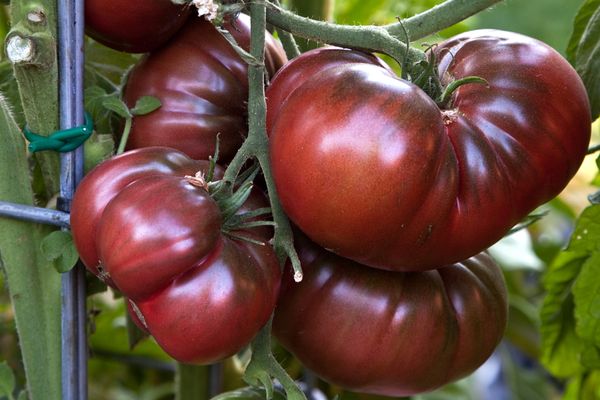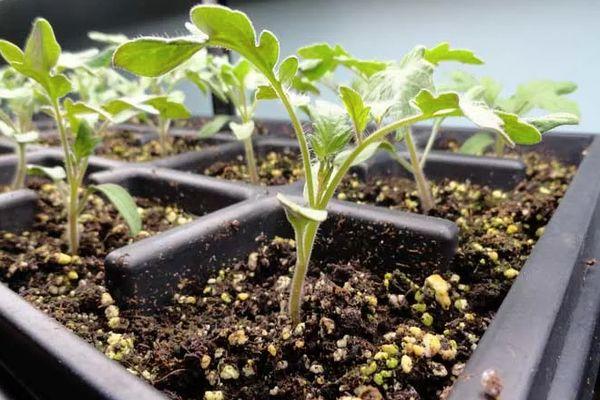Content
Among the variety of dark-fruited tomato varieties, the Black Bison tomato is especially loved by gardeners for its taste and unpretentious care. In addition to the fact that black varieties of tomatoes are considered one of the most useful, they also serve as an adornment of the site, due to the rich color of leaves and fruits. This article describes in detail the Black Bison tomato variety, its appearance, characteristics, planting rules and subsequent care.
Detailed description of the variety
Tomato Black Bison was bred by domestic breeders specifically for growing in greenhouses, so it can bear fruit all year round. The Bizon variety, bred by American specialists, was taken as a basis and as much as possible adjusted to our climatic zones of Russia. Therefore, this variety feels good outdoors under favorable climatic conditions.
Tomato Black Bison belongs to medium-grade, interdimensional (tall) and large-fruited varieties. The height of an adult bush reaches 1.7 - 1.8 m, in rare cases - 2.3 m. Young leaves have a light green color, which acquires a darker tone as the plant grows. The leaves themselves are elongated and velvety. The stems are short, well developed and knobby.
Inflorescences of bright yellow color begin to form above the seventh leaf and then form every two leaves. After 110 - 115 days after sowing the seeds, the first crop can already be harvested.
Description of fruits
The fruits are very large, slightly ribbed, with a fleshy, slightly flattened shape, with juicy, low-seeded pulp. The skin of tomatoes is thin and delicate, purple-violet in color, and has a tendency to cracking. The average weight of one tomato is 300 g, but some reach a weight of 500 - 550 g. The taste of the Black Bison is bright, slightly sweet, with a pronounced fruity aftertaste.
Ripe fruits are used both raw for making salads and processed into tomato juice (especially large ones), various sauces and dressings. This variety is not suitable for salting or canning, since the skin does not withstand heat treatment and pressure.
It is thanks to anthocyanins that the Black Bison tomato has such an unusual color of the skin and pulp of the fruit.
Characteristics of the tomato Black bison
The Black Bison variety has a high yield and, with proper care, one bush per season gives up to 5-6 kg of fruit (up to 25 kg per square meter). To increase yields, Black Bison tomatoes are fed, and the plant also needs to be watered regularly. In addition, to improve yields, it is recommended to form a bush into two trunks, regularly removing stepchildren and lower leaves.
In heated greenhouses, the Black Bison bears fruit all year round; in the open field, fruiting dates fall at the end of the last month of summer. On average, the growing season of a crop is 165 - 175 days.
The fruits can be transported, but they are prone to cracking and are not very good keeping quality.
The variety has good immunity to many diseases common among the nightshade family, but is prone to brown rot. Drought tolerant, photophilous.
Advantages and disadvantages
Tomato Black Bison is loved by gardeners, because it is unpretentious in care and has high gastronomic qualities. The advantages of the variety include:
- high taste properties;
- large-fruited;
- disease resistance;
- yield;
- high germination of seeds;
- drought resistance;
- fruiting all year round.
However, this variety also has some disadvantages:
- tendency to cracking;
- poor keeping rates;
- exactingness to lighting.
Another feature of the Black Bison tomato, which can be attributed to the disadvantages, is a long ripening period. On average, this figure is 15 - 20 days longer than other hybrid varieties.
It is important to provide the plant with good lighting, otherwise it will release too long shoots, and the fruits will become smaller.
Growing rules
Seed germination and the future harvest of the Black Bison tomato directly depend on the correct selection of seed, soil preparation and compliance with the rules for further care of seedlings.
Sowing seeds for seedlings
To increase germination, only healthy seeds are selected for sowing, without visual defects and mold. One of the quality control methods is to put them in a container of salted water (1 tablespoon of salt in a glass of water). Reject seeds that have floated to the surface.
Seed boxes must be disinfected with steam or potassium permanganate solution. After that, they are filled with a special substrate with an acidity of 6.2-6.8 pH, which you can buy or prepare yourself from peat, drained garden soil with the addition of compost (ratio 2: 1: 1).
In the substrate, at a distance of 5 cm from each other, grooves are made with a depth of 1.5 cm and seeds are planted with an interval of 7-10 cm, after which they are carefully sprinkled with soil and watered. Then the boxes are covered with plastic wrap and put away in a warm place. On the 7th - 8th day, sprouts appear: the boxes are moved to a lighted place.
As soon as the seedlings have 3 real leaves, they must be dived and fed with mineral fertilizers.
Transplanting seedlings
Transplanting seedlings begins on the 70th - 75th day in open ground or on the 60th day when grown in a greenhouse.
Under the conditions of cultivating the Black Bison tomato in the open field, soil preparation is carried out in the autumn. The soil is dug to a depth of 8 - 12 cm and organic fertilizers are applied. A week before planting, in the spring, mineral fertilizers are applied, and two days before the planting, the soil is disinfected with a solution of potassium permanganate. Seedlings should be planted in the evening or during the day, in cloudy weather.
Before planting in open ground, it is advisable to harden young plants. To do this, within two weeks, the boxes are taken out into the street (at a temperature of at least 15 oC), increasing the duration of stay in the fresh air every day.
When grown in greenhouse conditions, the seedlings can be immediately transplanted to a permanent place.
Since this variety is tall, the seedlings are planted at a distance of at least 50 cm from each other, ideally no more than 4 plants per 1 sq. At the same time, in order for each plant to have enough light, they are usually planted in a checkerboard pattern.
Tomato care
Further care after transplanting seedlings to a permanent place consists in watering, feeding, garter and removing stepchildren.
Water the plants sparingly until ovaries form. During the period of pouring and ripening of fruits, it is necessary to water abundantly - the yield depends on this.
It is also important to cut off stepchildren in time so that the plant does not waste energy on them. In addition, the removal of stepchildren and lower leaves is the prevention of fungal infections.
Since the Black Bison variety has a very powerful bush, it is necessary to tie up not only the main shoot, but also the side branches to a vertical or horizontal support. The brushes are also tied so that the shoots do not break under their weight of the fruit.
This tomato variety loves nitrogenous, potassium and phosphorus fertilizers.By the appearance of the plant, you can tell which element it lacks:
- a lack of potassium is indicated by twisted leaves covered with brown-yellow spots;
- with a lack of nitrogen, the bush slows down growth, loses leaves;
- a bluish stem with gray leaves indicates a lack of phosphorus.
The first feeding is carried out with nitrofoskoy on the 20th day after planting the seedlings in the ground (1 tbsp. L. Per bucket of water). The second time is fed after 10 days with potassium sulfate (1 tsp for a bucket of water).
It is necessary to apply organic fertilizers to the Black Bison tomato throughout the season once every 2 to 3 weeks, alternating with watering.
Conclusion
Tomato Black bison, with proper care, is able to delight with a stable, high yield throughout the year in a heated greenhouse. The variety does not require special care, therefore novice gardeners can easily grow it. And the taste and the undoubted health benefits of this unusual vegetable made it very popular among tomato lovers.











